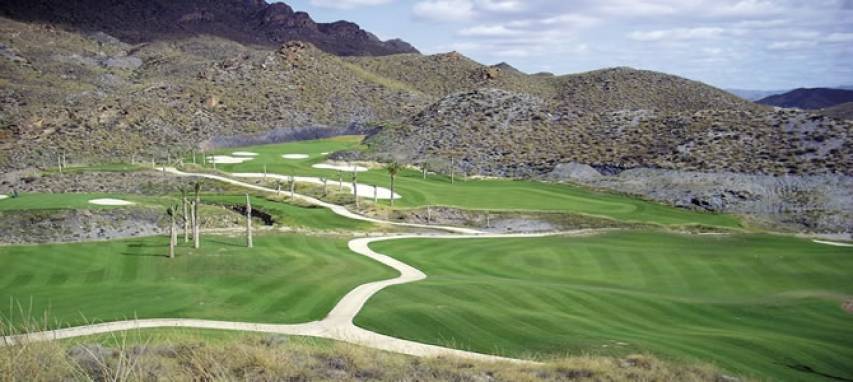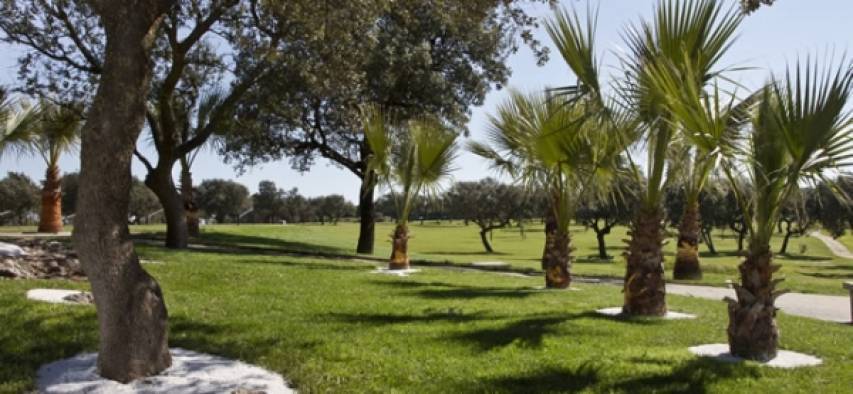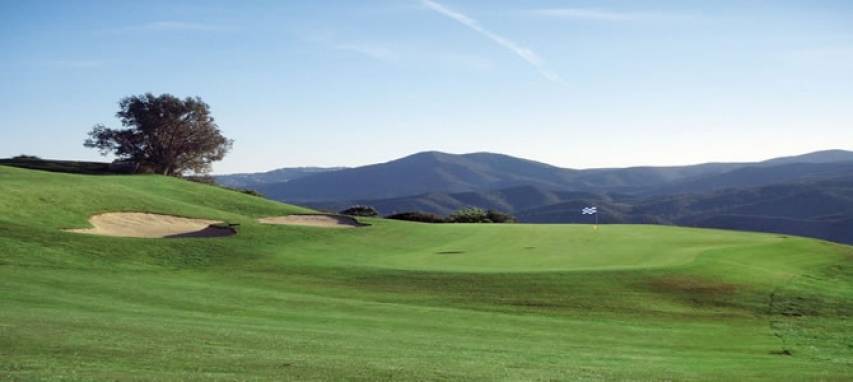He arrives for the interview at the appointed time (a conveniently broad spectrum – between 12 noon and 1pm) after completing his daily routine in the gymnasium. At the bar he asks for a sparkling water and black coffee but, just as the interview is about to begin, the manager of the Miguel Ángel Jiménez Golf Academy takes him aside for “a couple of minutes” to discuss a business matter. When he returns, the hot drink has become cold and the cold one slightly warmer. Not that the interruption was excessively unreasonable, however.
A bright sun warms the day in spite of a few irreverent clouds occasionally blocking its rays. The practice range and nine holes are packed with players enjoying their favourite leisure pursuit in short sleeves. Two of Miguel’s brothers are hitting balls, and another two are wandering around the golf complex.
One of the brothers, who lives in the Canary Isles and has a paint and bodywork workshop, trained Miguel Ángel to become a mechanic when he was still a teenager and golf had not become the main focus of his professional life. Turning up later at the academy is his younger son Victor, soon due to continue his studies at the University of Florida, where he is a member of the golf team and is forging his own dreams.
It is 27 December and, bearing in mind how hot the weather is, it doesn’t seem like we are in the middle of the festive season. “The world’s most interesting golfer” – as he was dubbed by the U.S. press several years ago – is not all that comfortable giving interviews, and he asks if there will be many questions. He takes a sip of coffee, and another from the water bottle. We begin the interview.
How does it feel to be considered the world’s most interesting golfer?
In the United States – well, everywhere these days – they have a descriptive term for everyone. I was playing very well in the Ryder Cup and the U.S. captain at that time, Ben Crenshaw, came up with the epithet.
What are your professional plans for 2018? Have you already prepared your tournament schedule?
It will be like the previous year: I’ll play 90 per cent of the tournaments in the United States, on the Champions Tour, and the rest will be a few sorties onto the European Tour. I’m still enthusiastic about playing and I believe I have the innate qualities required to continue battling to win a tournament.
Bernhard Langer, who turned 60 in 2017, won seven Champions Tour titles, plus two runners-up finishes, three third places, 16 top-10s… How does he do it?
He’s an incredible player. He stays in good shape and he’s playing the same as he has the past 40 years. He has complete control of his game, and that’s why he’s still there.
Second in the 2000 U.S. Open, third in the 2001 British Open, fourth in the Masters at Augusta in 2014… Have you ever felt you were on the verge of a major victory?
Yes, but the problem is that this is golf, we are all competing against each other, and winning is always difficult in any place and under any circumstances. In the end, the one who is most focused mentally is the one who secures the win.
Spieth, Rahm, Thomas, Matsuyama, Koepka… the twentysomethings are all up there. Is there increasingly less scope for the veterans to succeed on the main tours?
There is scope for the veterans, but it’s logical that the young ones are putting on the pressure because they’ve learned from all the veterans who are out there and they have the same attributes.
Were there as many young players winning when you started out on the European Tour?
Perhaps not as many, but there was Severiano Ballesteros, Olazábal, Sergio starting out… there have always been some players who have shone since they were very young. Perhaps not in the same numbers as we have now but there have always been young players who have stood out – someone in each generation.
During the Andalucían Golf Awards presentation you said you were the last of the generation of Spanish golfers who have won on the Tour and who began as caddies: Seve, Cañizares, Piñero… Was the difference, in some way, quite pronounced between those who came into the world of golf like you did and those who came from the amateur ranks such as Olazábal and those who followed them later?
It was different. We weren’t able to play in championships because we couldn’t be amateurs. Caddies were caddies and could play in tournaments as candidate-professionals. When you were a caddie-golfer you went on to become a candidate-professional and from there, completing your rounds and exams, you became a professional. There was demand for professionals in Spain, and the world of golf was fed by the caddie ranks, because there was no other source. Golf at the time was extremely exclusive, elite or however you want to describe it. Thankfully not so much now – it’s more accessible to people. I was the last of that generation of caddies, and Olazábal was the first of the new generation who came from the amateur game. These days everyone comes from there. The difference previously, between players with spending power and those without, no longer exists.
Did you note any kind of discrimination between those coming from the amateur world and those who had been caddies? Was there any social bias?
The difference was apparent, but eventually it ended.
This season you celebrate 30 years on the European Tour. What has changed most – in both a good and a bad sense – during those three decades?
It has all become much more professional. When I began there were no courtesy cars, no balls on the practice tee like now, the whole infrastructure, hotels, officials… Now there is an organisational chart to ensure that everything is all well organised and players only have to focus on playing and not worry about anything else. They monitor the courses, the greens, and make sure there is a quality standard for each tournament in every aspect. Over time, there have been more improvements and greater investment, because it has become clear that this is a sport that attracts a lot of people, and it is positive to be a part of that.
What has been the most emotional and exciting moment of your professional career?
All wins are good, all of them. I’m not going to say that one is better than another, although obviously when I won the 1999 Turespaña Masters at the Parador it was very moving because I was born and raised just two kilometres away, and my friends were all from there. That same year I won the Volvo Masters at Montecastillo (the only Spanish winner of that tournament)… I won at Wentworth (2008 PGA Championship)… My first tournament win was the Belgian Open in 1992, playing the final day with Nick Faldo, who at the time was at the peak of his career (that same year he won a fifth major)… There have been many good moments in my career. Some tournaments provide you with more money than others, and that’s normal, because some have greater prizemoney than others, but the important thing is that winning makes you feel good and motivates you – and, furthermore, that you achieve this in different periods of your life.
You have played – or competed during the same era – with the greatest golfers in the world, from Jack Nicklaus, Arnold Palmer and Gary Player to Tiger Woods and Severiano Ballesteros. Who is it that has left the most lasting impression, both in a sporting and human sense?
Seve and Tiger. When I competed with Nicklaus, Player and Palmer, the truth is they weren’t playing at their best, but I have played with Ballesteros and Tiger when they were at their peak, and those are the two who have impressed me most.
Tiger seems set to be able to compete in tournaments again, and he wasn’t in all that bad form in his recent appearance. Do you believe it is possible that he will be able to play at the same level again and challenge the new stars?
I believe so. If there is anyone who, after what he has gone through, has any possibility, it’s him – that’s for sure. All the operations he has had on his knee and back, and his talent, ability and competitive spirit… because he has been the mirror that reflects out on all the young players coming up in the game today, preparing themselves physically like athletes. Tiger has truly had a galvanising influence on the modern game. Thanks to him, and how he has moved around the world, playing everywhere… he has promoted golf in an incredible way in all its facets. The game owes him a lot and, due to his temperament and talent, he is the only player who could return to the top after everything that has happened to him. I saw some images of him in the tournament in the Bahamas (Hero World Challenge in December) and the swing he has and the speed he propels onto the swing indicate that his back is okay now, like in previous years. And we can only hope that Tiger returns because, without diminishing the merits of those players rising to the top now – who are very good, quite impressive – Tiger is Tiger and still stands out from the rest. I don’t really like to make comparisons but Tiger is exceptional.
Who is the best: Tiger or Nicklaus?
As I said, I don’t like to make comparisons. They are different times and each one has made his mark during an era, as Severiano did.
And among the new stars… do you think one of them could mark out a new era?
We have Rory, we have Jordan Spieth, who are the ones you would most likely opt for in this respect – but let’s see what happens.
And what can you tell us about Jon Rahm?
He’s starting out now and has sensational potential, outrageously good. He’s 23, and during his first year won on both tours (U.S. and European). What can we say about him: simply that if he continues to rise up the ladder as he has been doing we will have Jon Rahm here for a long while, and I hope he proves to have the same charisma and drawing power as those other players we mentioned.
Sergio García’s year also wasn’t all that bad…
Sergio has been banging on the door of a major for many years, and it was his turn. Mickelson won his first one at 37 and now he has five.
Talking about age, you hold the record as the oldest player to win a tournament on the European Tour, at 50 (2014 Spanish Open). What was that experience like?
Really good. That’s why I say I will be competing in some tournaments on the European Tour – not like before, now in a more relaxed manner – but I still see myself as having options and I’m working towards that. When the moment arrives that I see I can’t compete at a level where I believe I can win on the European Tour, that’s when I’ll say it’s over – I won’t play on the Tour any more. That’s very clear, and that moment will arrive – it’s coming slowly, but it’s coming.
And the future of the Jiménez golfing dynasty? How do you see this panning out for your sons Victor and Miguel Ángel?
In golf, 80 per cent of it is in the head. The rest, if you work hard, is to be patient and persevere – which is the most important thing.
Have you ever thought – at some bad moment – about putting away your clubs for good?
No, still not. No, because I don’t know what else to do in my life, and what I do is what I like doing.
How is your facet as a course designer proceeding?
It’s at a standstill. I have a completed design in the Czech Republic and I’m working on a project that isn’t progressing much in the Dominican Republic. If anyone is interested, I’m here, but I’m concentrating on playing and not looking for somewhere to build a golf course, and maybe that’s why I’m a little disconnected from the industry.
As someone who likes good cars, what new supercar would you ask the Three Kings for?
None. I have a Ferrari and right now I’m using a rent-a-car. I’m actually hardly ever here (Costa del Sol). I come here every now and again to see my brothers and see how this (his golf academy in Torremolinos) is going. I spend the year competing around the world and now I live in Austria (his wife’s home country), so it doesn’t make sense to have a car that is always in the garage and not being used.








